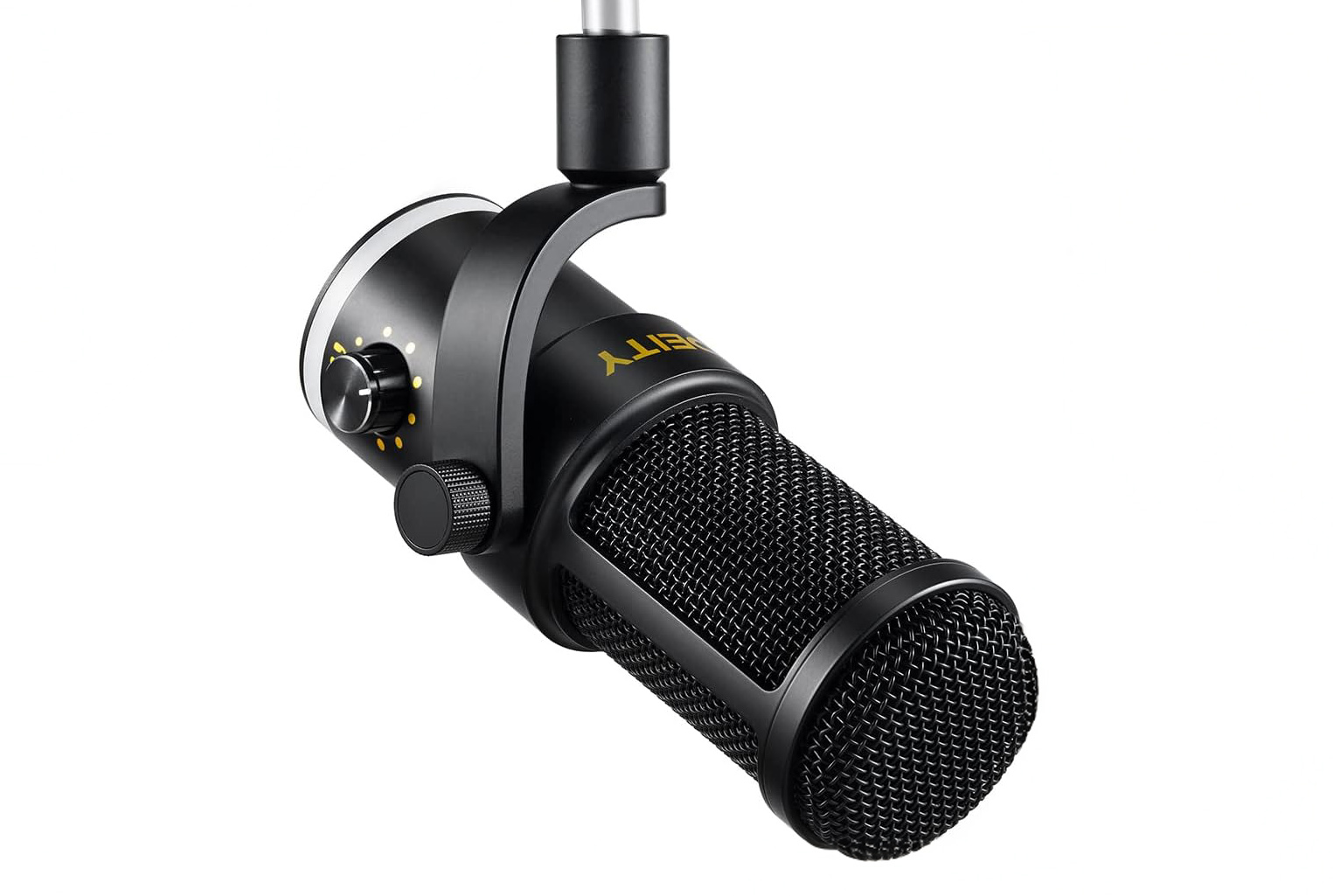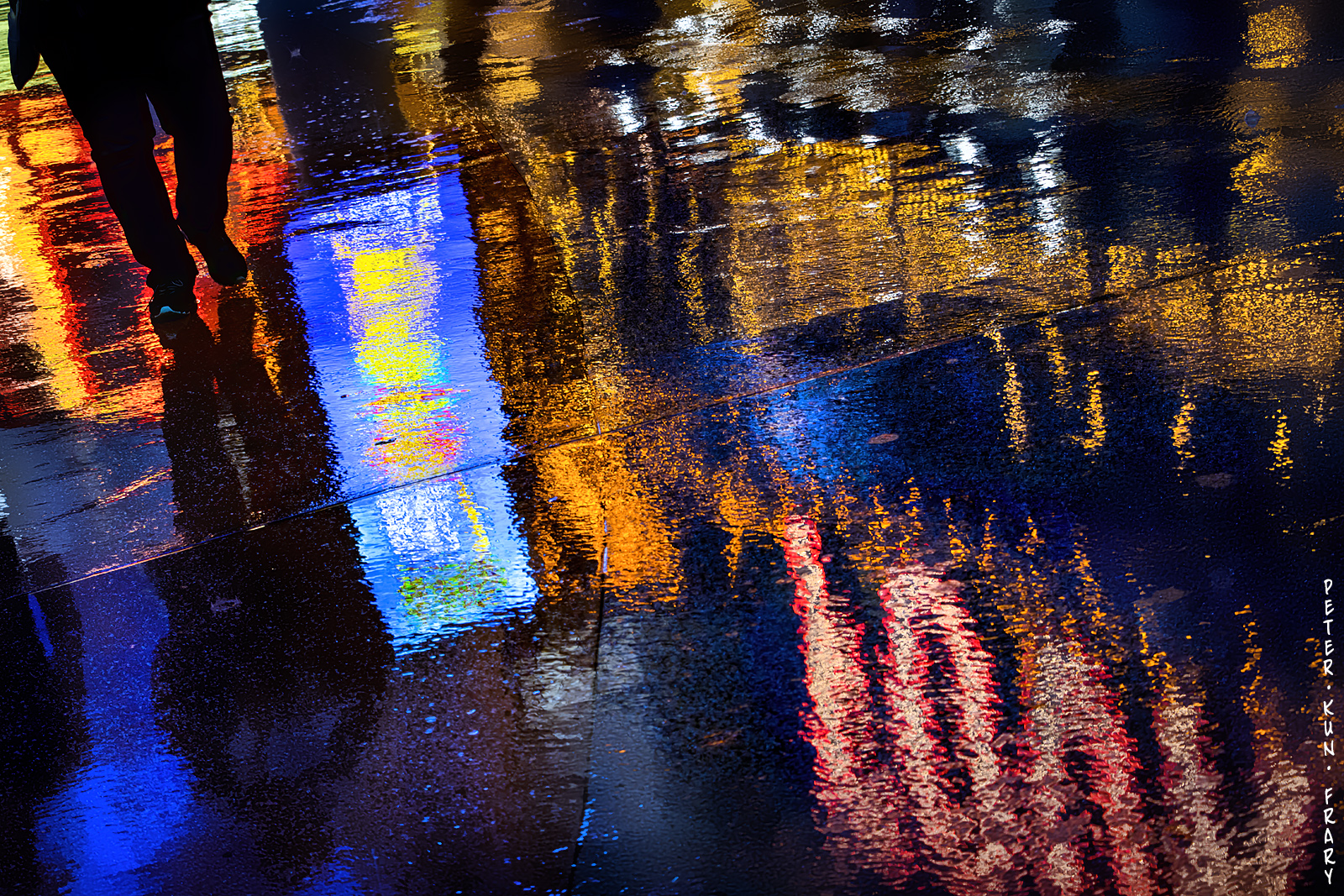. Deity VO-7U USB MicrophoneExperiences with a Podcast Style Dynamic Mic Peter Kun Frary. .
|
Boom ArmThe included boom arm is sturdy but only articulates on the second segment. In other words, you're stuck with one upright angle at the base, limiting reach and positioning. With that said, the arm works fine if you only need rotation and angle changes in the upper segment. The arm must be mounted close to your speaking position to be useful. Also, due to a lack of cable management (hideaway channels), it's less tidy looking on camera than some other booms. Finally, it only has a 3/8" thread. |
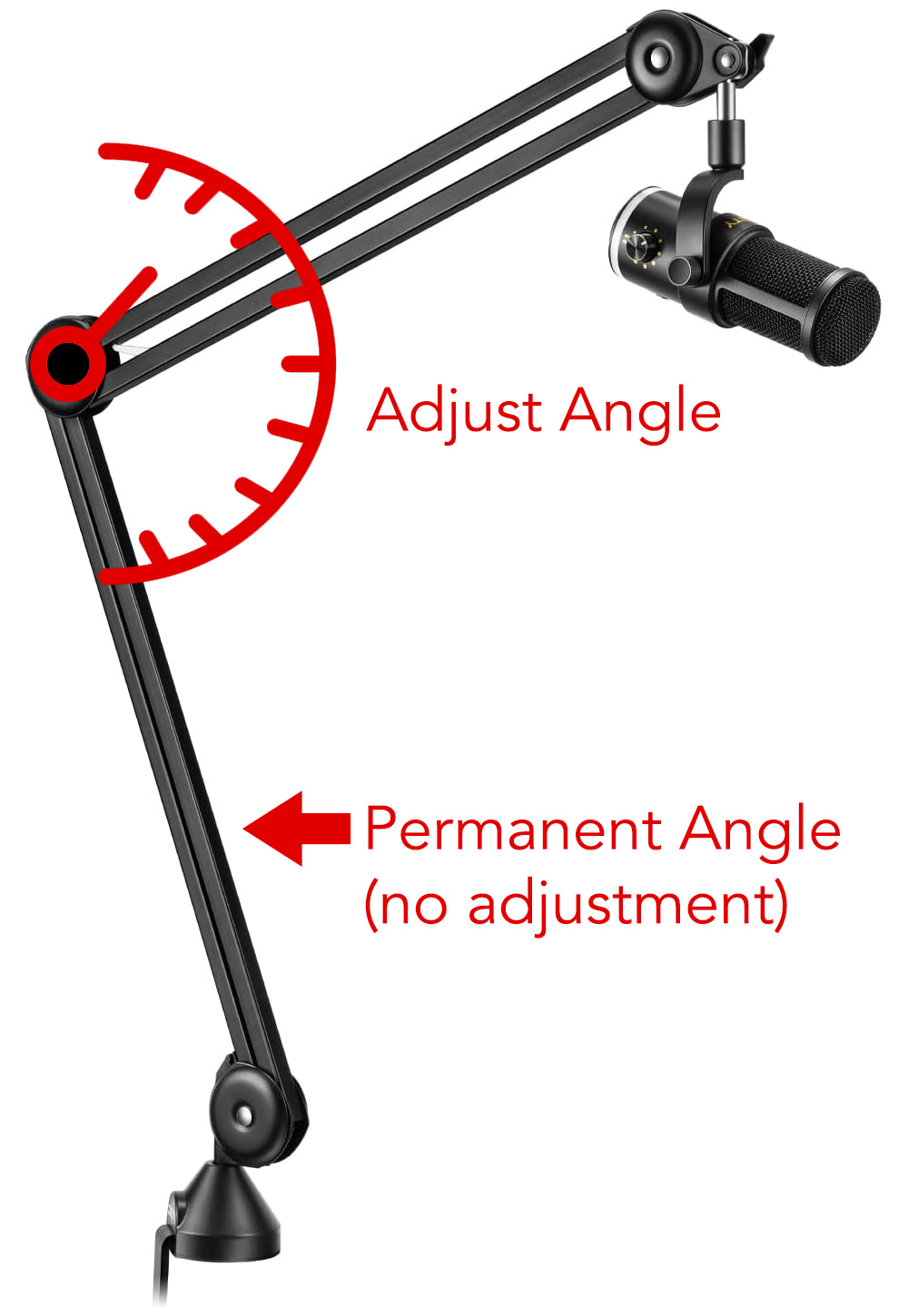 |
I prefer my InnoGear Mic Boom Arm over the kit boom: articulates both arm segments, has a channel to hide the cable, a standard 1/2" thread, is more heavy duty, and better looking. It can actually hold a 900g (2lb) Rode PodMic. If I were to do it again, I'd buy the basic mic kit and buy a better boom arm.
Deity VO-7U in "Apple" White | The VO-7U is powered by USB—no batteries required. The USB-C port is on the back. | Image courtesy Deity
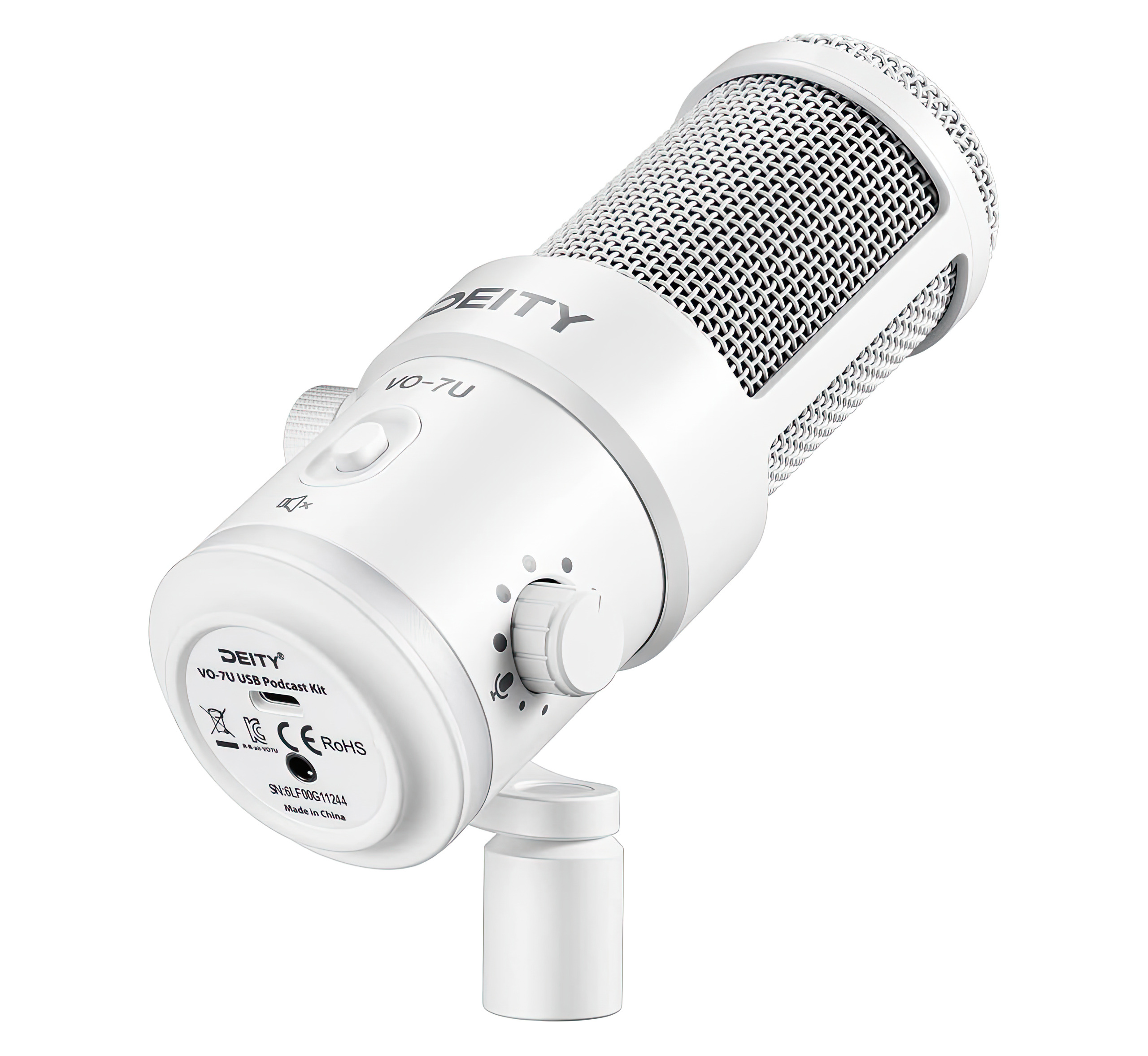
Controls
I'm used to mics without physical controls but appreciate the gain and mute controls on the VO-7U. No messing with software for gain tweaks. It lacks a high pass filter but has a hardware based limiter. It engages when gain is at 50% or higher. The limiter worked well—never clipped—and I didn't hear artifacts when output approached 0dB. I'd prefer a switch to toggle the limiter on/off.
Shock Mount
The VO-7U lacks an external shock mount. When mounted on a boom, it picked up vibrations from my desk, especially percussive taps and hum from my backup drives. I attached the VO-7U to my YOUSHARES Blue Yeti X shock mount and it nixed the hard drive and desk vibrations. Since the VO-7U has a cradle yoke, it should fit most shock mounts for cradle or hanging mics. In fairness, most of my mics need a shock mount when mounted to my desk, but the VO-7U is more sensitive to vibration than average.
Deity VO-7U | On a YOUSHARES Blue Yeti X shock mount.
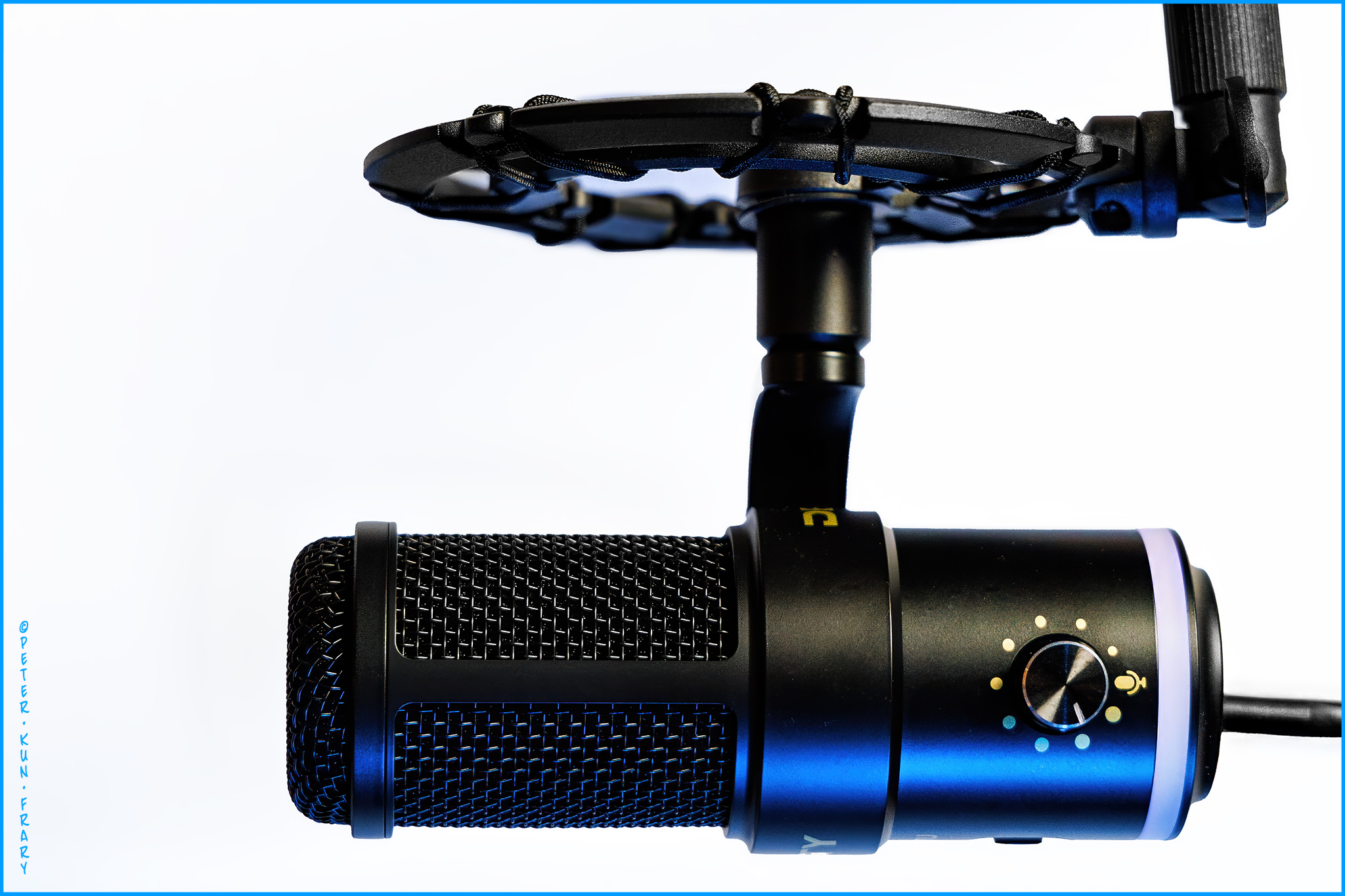
RGB Lighting
To appease gamers and New Age podcasters, the VO-7U has RGB lighting effects, twelve of them! Long press the gain knob followed by quick pokes to cycle through a rainbow of colors and assorted psychedelic pulsing on a LED light ring. Reminds me of my wife's New Age hippie EO diffuser.
An illuminated level display instead of the light show would be a better choice. However, the light ring has one useful function: a red pulse to show mute is on.
Thankfully, the default for the LED light ring is off. If you want it on, it must be reactivated after each power shutdown.
Connectivity
The VO-7U has USB-C and a 3.5mm jack for headphones. There is no line level out and, unlike its nearest competition, the Rode PodMic USB, Shure MV7 and Samson Q9U, the VO-7U lacks an XLR port. Thus, this mic can't be used with mixers, cameras or audio recorders. If you want to jack into a Zoom or Tascam audio recorder, it's not happening with this mic. The VO-7U only works with computers, smartphones and tablets.
Headphone Output
A headphone cable tangling off a mic is not good for recording—a single bump can ruin a track—and adds clutter if visible in videos. However, for casual use, I understand the attraction of a headphone output.
I plugged my Sennheiser HD 650 into the VO-7U headphone preamp and it sounded horrid: weak gain, fuzzy reproduction and RFI galore.
I use an iFi amp or Tascam 208i audio interface for monitoring, so the poor headphone output of the VO-7U is a non-issue for me. However, this funky headphone preamp might be a deal-breaker for some people.
 Computer Use
Computer Use
The VO-7U was plug and play on my iMac and MacBook Pro under Sonoma 14.5. It works jacked into a USB-C hub or straight into my Macs. No restarting or messing with drivers. Plug in and it appears in the system sound panel and/or recording app. Select the VO-7U in the recording app and/or system and it works. I've used it with Logic Pro, TwistedWave, OBS, Final Cut Pro and Adobe Audition and encountered no problems. Oddly, it even works in Shure's Motive Mix (beta).
I don't have Windows, Android or iOS devices, but Deity says the VO-7U is compatible.
Vegas Neon Reflections | EOS 90D and EF-s 18-135 3.5-5.6 IS USM
 Sound Quality
Sound Quality
The VO-7U has a classic dynamic mic tone and sounds good for male speaking voices. I have no experience with female voices but I suspect it sounds fine. Optimal vocal tone is from 3 to 6 inches straight on or offset 25 or 30 degrees. Offset speaking rolls off the highs slightly (my preference)
The VO-7U has a slight EQ bump around 5000 Hz. That boost in the lower highs gives it a tonal character somewhat reminiscent of Shure dynamic microphones such as the SM58, but with bass frequencies rolled off slightly more.
Gain
For my soft spoken style, the VO-7U needs mic gain at 75 to 100% for good levels (-12dB) but output is clean. A loud talker is likely to be around 50 or 60%. Output is about 6 dB hotter than the Rode PodMic USB, but weaker than the Blue Yeti X.
RFI Resistance
In RFI infested downtown Honolulu, I encountered no static or rogue radio stations while using the VO-7U on my Macs. Alas, I wish this mic worked on cameras.
Sound Isolation
The super cardioid polar pattern of the VO-7U is focused on sound near the front of the capsule, rejecting off-axis sound. In other words, distant traffic and AC rumble are reduced compared to omnidirectional and many cardioid mics.
VO-7U Super-cardioid Pattern | Best sound pickup is between 330 and 30 degrees. Sounds are reduced or rejected on rear and sides of mic.
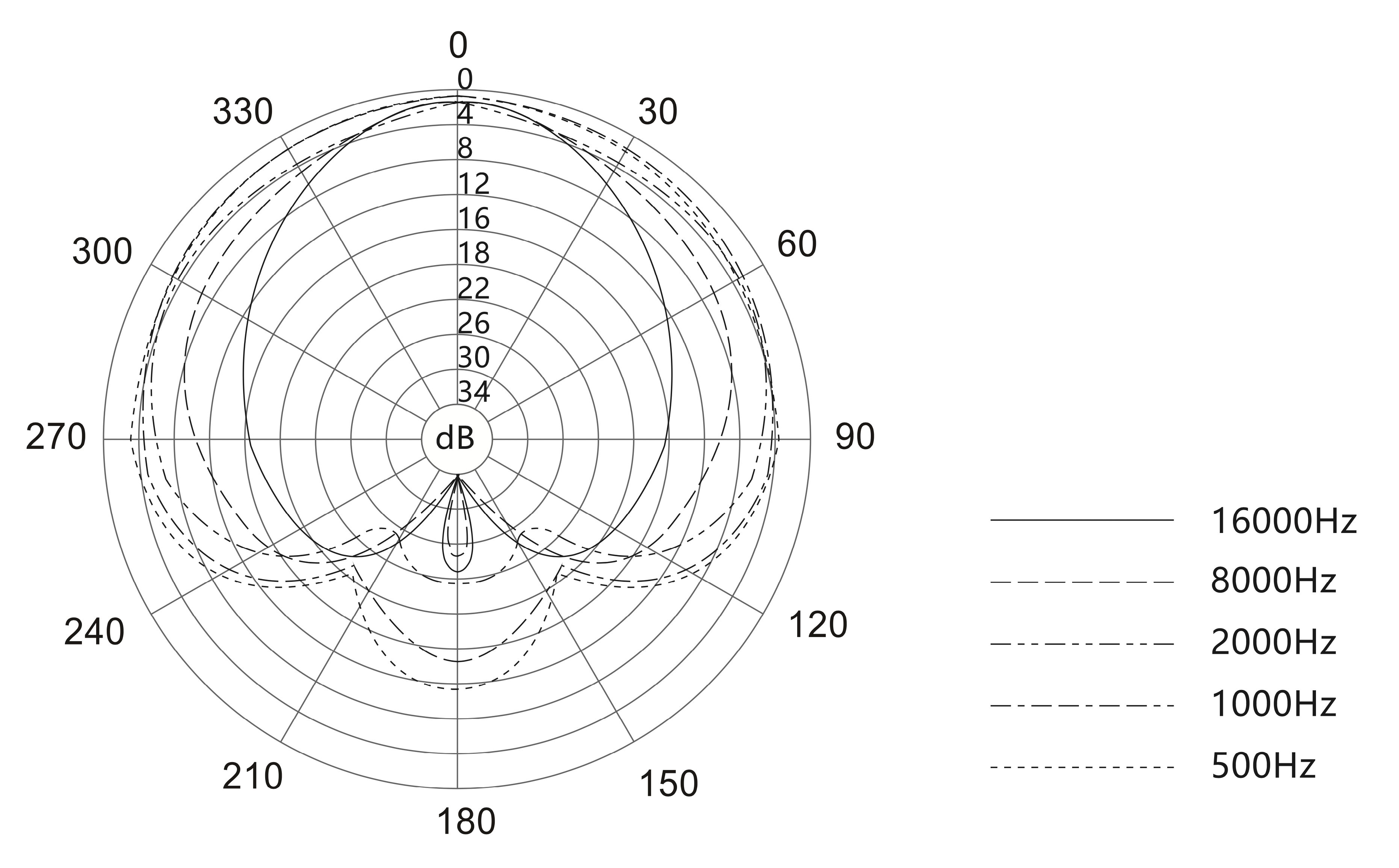
The fact that the VO-7U is a dynamic mic, rather than a condenser mic, also makes it less sensitive to background noise. The downside to dynamic mics is the lower sensitivity requires high gain levels and close mouth placement.
 Using the Deity VO-7U
Using the Deity VO-7U
While working with the VO-7U I found it consistent in performance and easy to use. Here's my first talking head and voiceover video done with the Deity VO-7U.
Staff Notation and Musical Pitch | Talking head and voiceover passages recorded on the Deity VO-7U.
I recorded the voiceover in Logic Pro. No processing other than trimming audio clips and normalization. For precise positioning in the timeline, I bounced each topic as a separate audio clip.
The final component was shooting the talking head scenes with a Canon EOS R6 MK II and Godox UL60 video lights and soft boxes. I used the VO-7U on set, jacked into a MacBook Pro running Logic Pro.
I assembled the componets in Final Cut Pro. It took me a week of toil to create and assemble all the elements for a 4 minutes and some seconds video!
 Sound Comparisons
Sound Comparisons
If you're interested in how the VO-7U compares to other mics, below are audio samples of most of the mics I've used for voiceovers. For the samples, I spoke from 8 to 10 cm away. Microphones were mounted on a boom clamped to a computer desk in a partially treated room. I recorded into TwistedWave at 48 kHz and 24-bits. Gain was staged at -12 dB. No processing or normalization was used. Mics were fitted with a foam pop filter unless otherwise noted.
Deity VO-7U
The VO-7U is crisp and clear sounding. While there is no controlling software, the VO-7U has a limiter and powerful built-in preamp.
For off-axis sound rejection, the VO-7U performs nearly as well as my favorite mic, the Shure 849. However, as mentioned earlier, the VO-7U picks up vibration and hum easily and needs a shock mount.
The Deity VO-7U kit sells for $199 USD.
AKG C3000B with Shure MVX2U
The AKG C3000B, circa 2009, is a large diaphragm side-address condenser mic. It remains in production as the AKG C3000 and sells for $350 USD. The lower treble frequency bump makes it too bright for classical guitar. On the other hand, that bump makes it a good mic for spoken word, exhibiting clarity, detail and a bit more treble bite than the PodMic USB.
The C3000B was recorded with USB-C output from the Shure MVX2U USB interface. Gain was set at 46 dB in ShurePlus MOTIV.
Blue Yeti X
The Blue Yeti X was my first non-XLR mic, purchased during the Great Plague of 2020. It gets a lot of hate because of its popularity and, for that era, the teen gamer styling. I find it less aesthetically pleasing than average and yet it sounds decent and is flexible with stereo, omnidirectional, cardioid and bidirectional patterns. Off-axis rejection isn't nearly as good as the VO-7U or 849—background noise is apparent in this sample—but the mic is fine in a quiet room. Most USB mics—most mics—only have one polar pattern. And it needs a shock mount if you use it on a desk with a computer. The powerful built-in preamp, gain meter and software package set it apart from most mic designs.
Comica VM30
The Comica VM30 is a condenser shotgun mic designed for hot shoe or boom use. It supports TRS output for cameras, USB-C for computers and mobile devices and wireless via a built-in transmitter. A shoe mount receiver is included. It also features stepless gain control from 0 to 10 via a rear mounted dial.
For this example, I routed USB-C output to TwistedWave on my iMac. USB gain output is ample. With onboard mic gain at 9, levels averaged -10dB to -6 dB.
I spoke straight into the mic from 12 cm (5") away, resulting in smooth, clear and natural sound. A pleasant bass increase from 8 to 10 cm. The proximity effect becomes overwhelming if I draw much closer. About 25 cm (10") is the maximum speaking distance for really good vocal tone, albeit it is still usable at 50 cm. Beyond 50 cm, tone quickly becomes thin and farty. This mic is optimized for video blogging at arm's length.
Clarity is good and beats the mildly murky sound of the Deity V-Mic D4. Tone is a notch brighter than the MKE 400 and Rode VideoMic Go II but a pleasant and very usable sound.
The VM30 has a tight polar pattern, resulting in excellent off-axis sound rejection. Amazing, the Rycote style shock mount nixed external hard drive vibrations and I didn't have to turn off external hard drives.
With all of the above said, the real talent of the VM30 is its built-in wireless ability. Quickly go straight to camera, computer or audio recorder with no wires.
The Comica VM30 retails for $190 USD.
Deity V-Mic D4
The Deity V-Mic D4 is a shotgun microphone optimized for close use such as video blogging. It has TRS and USB-C output for connectivity with cameras, audio recorders, mobile devices and computers. In TRS mode, the D4 suffers from high levels of RFI. USB-C was used for this test sample and is RFI resistant. The V-Mic D4 has adjustable gain from -5 to +10 dB. With gain at +10 dB, USB output is low, about 6 dB lower than the Rode VideoMic Go II.
My voice sounds slightly nasal, murky and compressed with the D4. The D4 has strong off-axis coloration. When recording at 25 to 45 degrees off-axis, high frequencies are severely rolled off compared to speaking straight into the capsule. For this test, I spoke straight into the mic.
Finally, the included foam filter reduced highs severely so I used a clip-on pop filter instead. I prefer the sound of the Comica VM30 and Rode VideoMic Go II over the D4. The V-Mic D4 retails for $100 USD.
Rode PodMic USB
The Rode PodMic USB, a dynamic mic with both USB and XLR output, is the main competitors for the Deity VO7U. This PodMic USB sample was recorded through its built-in USB-C port. Gain was maxed out at 63 dB in Rode Central.
The PodMic retails for $199 USD.
Rode VideoMic GO II
The Rode VideoMic Go II is a shotgun mic designed primarily for camera hot shoe use. Besides TRS analog output for cameras, it supports USB-C for computer and mobile devices. Unlike TRS output, USB-C is resistant to RFI. It is compatible with Rode Central for settings but I recorded without processing. It has a tight polar pattern and, along with the Shure 849, has better background sound rejection than other mics in this group. The USB output of this wee condenser mic is hot—gain was set at 25% for -12 dB.
The VideoMic Go II is tiny—size of a partially smoked cigar—and, for computer use, is at its best boomed just out of sight. It retails for $99 USD.
Shure 849 with Shure MVX2U
The Shure MVX2U USB interface was plugged into the XLR port of the Shure 849 and recorded in TwistedWave.
I bought a pair of Shure 849 condenser mics in the late 1990s to record classical guitar. This is an instrument mic—looks and sounds similar to the current SM137—with small diaphragm and minimal windscreen protection. It was too bright in the lower highs for classical guitar and is better suited for miking guitar amps and percussion.
Oddly, I found the 849 flattering for my speaking voice: smooth, warm and clear. It is surprisingly forgiving of plosives and small puffs of air. Because it was designed for isolating and miking stage instruments, off-axis rejection is excellent. It has extensive side vents to narrow the polar pattern and increase side rejection (like a quasi-shotgun mic). Like Shure stage mics, it has an internal shock mount to reduce handling noise. Among the mics I tested, it and the Shure Beta 57A were the only ones that picked up no vibrations or hum from hard drives and nearby AC units.
Shure Beta 57A with Shure MVX2U
And that was the sound of the Shure MVX2U USB interface plugged into the XLR socket of the Shure Beta 57A. This mic's isolation from background noise, handling noise and resistance to plosives is excellent—better than the Rode PodMic, Neumann TLM 102 and AKG C3000B. It ties with the Shure 849 and SM137 in terms of background noise rejection. It sounds great for spoken word, singing and miking guitar cabs! Somewhat plain on camera but what a studio workhorse.
Shure KSM8
The KSM8 was recorded through the XLR port of the Rode Streamer X with gain at 57dB. For this track, I spoke straight into the mic from 10 cm (4 inches) away. A pop filter or foam windscreen wasn't used.
Although designed as a vocal mic, the KSM has a significantly flatter frequency profile than the SM58. I love its more natural rendering compared to typical vocal and broadcast dynamic mics.
I don't have a shock mount for the KSM8, so I expected plenty of noise and vibration when testing it on a boom arm clamped to my computer desk. Amazingly, unlike most of my other mics, the KSM8 proved to be immune to hard drive and fan vibrations. Shure's user guide claims that an "advanced internal pneumatic shock mount and the Diaphragm Stabilization System (DSS™) work together to prevent handling noise." Apparently it also nixes vibration better than my other internal pneumatic shock mount equipped Shure mics.
This tough but beautiful mic sounds great: warm, smooth and easy on plosives and sibilance. Off-axis sound rejection is excellent. Among all my dynamic mics, I found the KSM8 the most flattering for my voice. It is also easy to work with, not too gain hungry, has a big sweet spot and tolerates close sound sources with only a slight but pleasing proximity effect.
The KSM8 is pricey, retailing for $399 USD, albeit I snagged one on sale for $319.
Thoughts
Each of these mics have their own character, but the VO-7U holds its own against the Shure 849 and AKG C3000B in terms of off-axis rejection. I find the tone of the VO-7U pleasant but, for my voice, the tone of the Shure 849, Shure KSM8, Rode VideoMic Go II and PodMic USM are preferable.
The 849 and C3000B are considerably more expensive than the VO-7U and require an audio interface. The Blue Yeti X is priced about the same as the VO-7U but includes software filled with presets for gaming and streaming. The most surprising mic is the tiny Rode VideoMic Go II: sounds good, only costs $99 and can be used in a camera hot shoe or as a USB mic with computers and mobile devices.
Honolulu Harbor | No RFI problems here. | EOS R and RF 24-105 4L IS USM

 Musings
Musings
For talking head sessions, I prefer an out of sight shotgun mic or a lavalier. But I couldn't whip RFI with my existing camera mics. Using outboard audio—VO-7U plugged into a MacBook Pro—was a good solution and, as a side benefit, the sound of my talking head was close in timbre and presence to the voiceover. With that said, my all-in-one role as speaker, sound man and camera man, would be easier if an audio recorder like a Zoom F3 or Tascam DR-60 MK II could be used on set instead of a computer.
Outboard audio requires syncing audio to video guide tracks in post production. For guitar performance videos, I always use outboard audio and sync in post for best audio quality. I was hoping to avoid the extra toil of outboard audio for 15 or 20 seconds of live speaking, but that was not to be.
 Final Blurb
Final Blurb
Deity doesn't provide mic settings software like Rode Central or Shure Motiv, so adjustments like EQ, compression, high pass, reverb, etc., must be done in a hardware mixer such as a RodeCaster Duo or in a DAW during post production. However, the built-in limiter is ideal for gamers prone to shouting during play. I basically liked the straight VO-7U sound as tracked and it needed little post production beyond normalization.
For $199 USD, there is lots of completion for the VO-7U. The 800 pound gorilla in the room is the Rode PodMic USB. It sells for the same price but has both USB and XLR outputs and industry leading software. And it sounds very good.
The bottom line is the VO-7U is a jim-dandy USB dynamic mic, ideal for podcasting, Zoom, streaming and voiceovers.
Finally, please help support this website by purchasing this item at Amazon:
Deity VO-7U (with table top tripod), black edition
Deity Podcast Kit (with boom arm), black edition
Louis Armstrong Mural | Eureka, California | ©Peter Kun Frary

 Features & Specs
Features & Specs
- Super-cardioid pattern
- Large diaphragm dynamic capsule
- 50Hz to 20kHz response
- 600 Ohms
- 24-Bit / 48 kHz with USB-C interface
- SPL of 135dB
- SNR 84 dB @ -24dB sensitivity
- USB bus power
- Headphone output with volume control for monitoring
- Cradle yoke with 3/8" and 5/8" female sockets
Weight & Size
- Dimensions: 58 x 153 mm
- Weight: 646 g
Deity VO-7U Podcast Kit | included accessories
Boom arm, 2 USB cables, foam windscreen, 3 cable ties, and paper manual
Deity VO-7U (basic kit) | included accessories
Table top tripod, 2 USB cables, 3 cable ties, and paper manual
Country of Origin
People's Republic of China (PRC)
Instruction Manual
Price
$199.00 USD
07/28/2024



